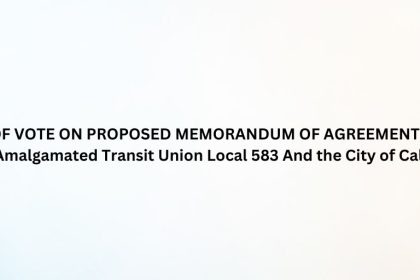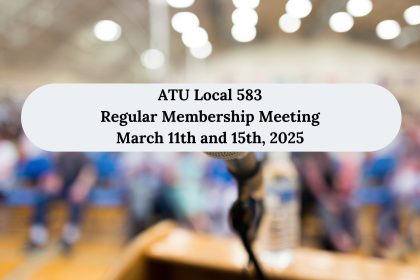Union History – The Winnipeg General Strike
As far as the historical events in Canadian Labour history, the Winnipeg General Strike is about as notorious as they get. Many of you may already know the gist of it, but for our first foray into Union history we wanted to start with a big one. Especially since there are many who may not know the details and how it correlates to ATU 583 today.
In the Spring of 1919 after a number of employers in Winnipeg outright refused to acknowledge and recognize the Metal Trades Council as the bargaining agent for metal shop employees these workers went on strike on May 2, 1919.
The employer’s refusal of recognition was appealed by the Metal Trades Council to the Winnipeg Trades and Labour Council. They voted strongly in favour of a strike. As a result, on May 15, 1919 over 30,000 Winnipeg workers did just that, they went on strike.
As metal shops, railway shops and construction sites came to a halt, so did transportation in general as the Amalgamated Members of Division 99 supported the strike as well (they operated the street cars in Winnipeg). More workers joined and industry after industry was halted.
The reaction from government and management was swift and brutal. A ‘Citizen’s Committee’ was created and armed members of this committee, who were mainly business owners and leaders, decided they were in charge of enforcing law and order in Winnipeg.
Many sympathy strikers (police, fireman and postal workers) were forced back to work and further coerced with the threat of job loss to sign pledges saying they did not support the strike, and they themselves would not go on strike.
As a result of these strike busting tactics the Winnipeg Trades and Labour Council struck a Central Strike Committee which was able to mobilize resources. As did other trade unionists Canada-wide.
This meant that 60,000 workers in British Columbia walked out. Leaving shipyards, dock loading and streetcars unable to function. Local Division 101 from Vancouver joined the strike officially on June 3, 1919 in sympathy with the members in Winnipeg.
Similarly in Alberta, Members of Division 569 Edmonton and in Saskatchewan, Members of 615 Saskatoon joined on May 30, 1919.
In a surprising show of solidarity, the returning soldiers from WW1 also supported the workers in Winnipeg. The Citizens Committee demanded they oppose the strike, but they in fact supported it with over 10,000 ex-servicemen demonstrating before Provincial legislature, demanding an immediate settlement which included retracting the demand for police and firemen to never strike and to enact legislation for collective bargaining.
The reaction to the massive show of support was further brutality. In June of 1919, Parliament amended the Immigration Act to extend to British subjects, permitting deportation by executive order without a trial. The same day this was taking place the mayor of Winnipeg banned all parades and the congregation of crowds. Three days later, the police commission fired the entire police force and hired special constables to replace them. On June 17, 1919 the RCMP raided the homes of known Unionists and arrested 10 Union strike leaders. Many were charged with sedition and would eventually serve time in jail.
On June 21, 1919 armed and mounted men rode into a crowd holding a silent protest against the arresting of the Union strike leaders. They fired approximately 120 bullets into the crowd of men, women and children. They killed two and injured approximately 30 more. This day has come to be known as “Bloody Saturday” and ended with federal troops occupying city streets.
This was essentially the end of the strike. Though many workers would be blacklisted or otherwise “punished” for their roles in striking.
However, the impact of the strike was evident in subsequent elections. Labour had elected some representatives prior to the strike but the number significantly increased afterwards at all three levels of government. This includes strike leader J.S Woodsworth. He and other former strikers formed the Cooperative Commonwealth Federation – which would go on to become to New Democrat Party (NDP).
In the short term, the Winnipeg General Strike did not achieve the gains for workers that was hoped for. It left a legacy of bitterness and controversy among organized labour groups across Canada. But in uniting workers around common goals, it also helped bridge divides between them.
What we can take away from this is that our foundation for ensuring fair collective bargaining and continued support of workers is to VOTE in labour and worker friendly representatives in ALL levels of government. After that, it has been our unified and collective voice that has carried us to where we are today. The strike resulted in an unprecedented improvement in labour laws and the standard of living for the average worker for decades. However, with the rise in anti-labour laws being legislated by Governments like the Alberta UCP, it is more important now than ever, that we do not become complacent. We would be fools to think that the gains we made in the last 100 years, will survive the attacks against workers over the next 100 years, or even the next decade, without a unified fight.
An interesting fact from the strike:
Labour activist Helen Armstrong, nicknamed ‘Ma’, was one of only two women among some 50 men on the Central Strike Committee. During the strike, she established the Labour Café, which provided women strikers with three free meals a day. This was an essential service for those who lost wages due to the strike. The café also welcomed men but encouraged them to pay or make a donation. It reportedly served 1,200 to 1,500 meals a day.
Of Interest:
For a visual/listening opportunity on the Winnipeg General Strike you can visit the linked YouTube video from Historica Canada
CLICK HERE
Sources for this article are:
-A History of the Amalgamated Transit Union 1892- 1992
-The Canadian Encyclopedia
-Wikipedia










